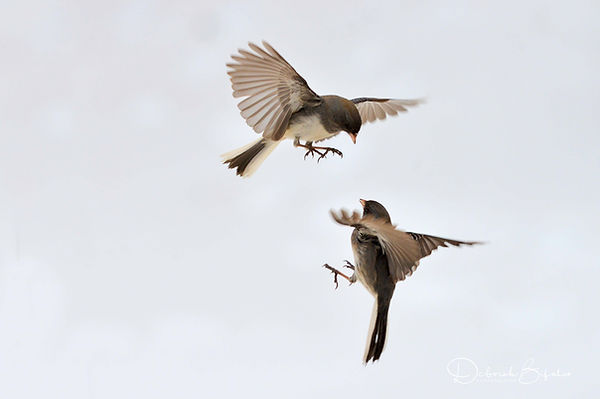
What's in Flight
February and March, 2019
In the depths of winter, when there are few signs of life in the park, one of the most welcome sounds is the lively chittering of the little brown House Sparrows that congregate in the trees and bushes, especially along the 86th Street Cherry Allee.

Fox Sparrow
Deborah E. Bifulco
House Sparrows are one of the most successful species on the planet. In New York, it’s estimated there are twice as many House Sparrows in the parks as all other native songbirds. Due to their large numbers, it is easy to take them for granted. But in Europe, the House Sparrow has all but vanished from the cities. British sparrow specialist, J Denis Summers-Smith, who has studied the House Sparrow since 1947, believes diesel exhaust fumes are the culprit.

House Sparrows
Deborah E. Bifulco
House sparrows are not indigenous to America. They are Eurasian birds that were first introduced to New York in the mid 1850s to combat an inchworm infestation that was decimating the trees in Central Park. Within 50 years, these hardy little birds had colonized America, Canada and Mexico. A 2018 study which sequenced the House Sparrow’s genome found its success is due in part to a genetic adaptation that enables these birds to digest starch, meaning that they can easily live alongside humans, which they’ve done for over 11,000 years, since the invention of agriculture. In the countryside they can feed off farming crops like wheat and corn. And in modern cities they supplement their natural diet of seeds, grasses and insects by pecking on crumbs of pizza, popcorn, and bread.

House Sparrows
Deborah E. Bifulco
If you see a House Sparrow on the ground flapping its wings and throwing up dust or mud into the air, it is not injured or playing, it is simply taking a bath. Dust bathing is a vital part of maintaining their plumage. The dust helps prevent feathers becoming oily or matted and ensures maximum insulation during the long winter months. The dust also discourages bird lice.
Not every little brown, grey and black bird in the park that looks like a sparrow is a House Sparrow. There are a number of American sparrows that also live in the park. ‘The two are not related,’ says Paul Sweet, Collection Manager of the Ornithology department at the American Natural History Museum. Early European settlers are to blame for the confusion. They misnamed several American birds, based on their superficial similarities to the ones back home. (A classic misnomer is the American Robin, which aside from a red breast looks nothing like the smaller British Robin).

Song Sparrow
Deborah E. Bifulco
‘American wild sparrows are subtly beautiful and have interesting patterns of browns and blacks. They are less chunky looking than the House Sparrow. But identification can be a challenge,’ says Paul. One of the most visible American sparrows this time of year is the White-throated Sparrow. It migrates down from more mountainous areas to the north to winter in the city. ‘You’ll see them hop around on the ground and scratch the leaves and grass with their legs looking for seeds. They have a white throat, black and white striped crown and yellow lores [a spot either side of the head between the eye and beak].’

White-throated Sparrow
Deborah E. Bifulco

White-throated Sparrow
Deborah E. Bifulco
The male House Sparrow by contrast has a black throat or ‘bib’. The larger the bib the more dominant he is. Next time you see a flock in the park, check out who is fighting and who is getting first dibs on the food and its more than likely a dominant male with a large bib. The coloration of the female House Sparrow is muted, with soft gray-brown fluffy underparts and buff, brown and black wings.
Other American sparrows that flit through the park this time of year include the beautiful red Fox Sparrow with its streaky reddish brown and grey-white plumage, and black and yellow bill; the Song Sparrow famed for its trills and buzzes; the White-crowned Sparrow (with its black and white striped head) and the slate-colored Junco with its white belly and long tail. ‘The Juncos are sometimes called snowbirds, as in some parts of the country they arrive here with the snow,’ says Paul. ‘They breed in the spring and summer in more mountainous areas like the Catskills. And sometimes interbreed with the White-throated Sparrows as they are so closely related.’

Fox Sparrow
Deborah E. Bifulco

Dark-eyed Juncos fighting
Deborah E. Bifulco
As the weather warms up, many more American sparrows will arrive back in the park including the Chipping Sparrow (with its rusty crown), the Savannah Sparrow (with its streaky breast and yellow stripe over the eyes) and the vibrantly marked Eastern Towhee with its black head, back and wings, and chestnut red along its sides.

Chipping Sparrows
Deborah E. Bifulco

Male Eastern Towhee
Deborah E. Bifulco
Words: Lucie Young
Images: Deborah E Bifulco
Link: American Natural History Museum Ornithology Department http://research.amnh.org/vz/ornithology/index.php

